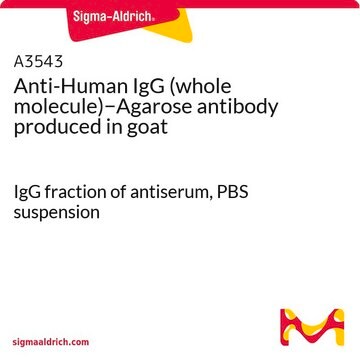A3316
Anti-Human IgG (Fc Specific)−Agarose antibody produced in goat
affinity isolated antibody, PBS suspension
Synonym(s):
Goat anti-human IgG
About This Item
Recommended Products
biological source
goat
conjugate
agarose conjugate
antibody form
affinity isolated antibody
antibody product type
secondary antibodies
clone
polyclonal
form
PBS suspension
species reactivity
human
should not react with
rat, mouse
technique(s)
Ouchterlony double diffusion: suitable
capacity
2 mg/mL, resin binding capacity (human IgG)
storage temp.
2-8°C
target post-translational modification
unmodified
General description
Goat Anti-Human IgG (Fc Specific)-Agarose antibody is specific for the Fc fragment of human IgG when tested against purified human IgA, IgG, IgM, Fc, and kappa and lambda light chains. No reactivity with mouse or rat IgG is seen by Ouchterlony Double Diffusion (ODD), prior to agarose bead coupling.
Immunogen
Application
Other Notes
Physical form
Disclaimer
Not finding the right product?
Try our Product Selector Tool.
Storage Class Code
10 - Combustible liquids
WGK
WGK 3
Choose from one of the most recent versions:
Certificates of Analysis (COA)
Don't see the Right Version?
If you require a particular version, you can look up a specific certificate by the Lot or Batch number.
Already Own This Product?
Find documentation for the products that you have recently purchased in the Document Library.
Customers Also Viewed
Our team of scientists has experience in all areas of research including Life Science, Material Science, Chemical Synthesis, Chromatography, Analytical and many others.
Contact Technical Service










